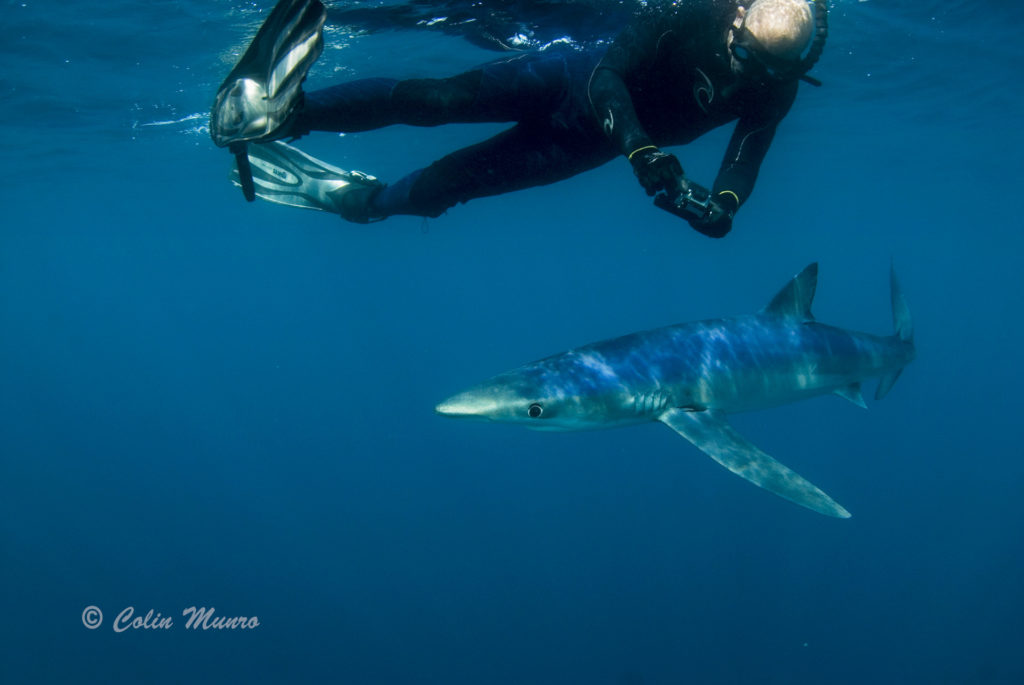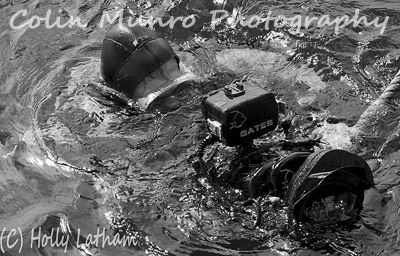An account of photographing blue sharks off Cornwall, Southwest Britain, a few years back, and a link to buying blue shark fine art prints of these amazing hunters of of the oceans at colinmunroimages.com.
On a clear July morning I stumbled out of my bunk (I was living on a boat at the time) at 5.30am, forced out my the insistent buzzing of my phone alarm. One hour, and one strong coffee later, I squeezed my dive bag into the back of Ritchie’s car and we were off. We had over a hundred miles to cover, and a boat to catch.

Charles Hood runs the best, and most successful, blue shark snorkelling operation in the UK. His boat, a large rigid-hulled inflatable (RIB) operates out of Penzance, almost at southwesternmost extremity of the British mainland, so that’s where we were headed. The boat is a fast open boat, perfect for getting us 10 miles offshore quickly, but small and devoid of any shelter from the elements. So we changed in to wetsuits on the quayside, packed our camera gear in dry bags carefully padded with towels and sweatshirts for the bouncy ride out, and we were off.

Each year blue sharks arrive off the coast of Southwest Britain, normally sometime in mid-June and remaining until mid-October. Blues are true oceanic sharks; they inhabit deep water, only infrequently venturing on to shallower, continental shelf waters. They are found in tropical and temperate oceans around the globe. However, in the tropics they tend to stay in deeper, cooler water but are often observed in surface waters in temperate seas. They feed on fast moving prey such as squid and schooling fish. Much of their feeding appears to be done in deeper waters. We know this partly from studies looking at gut contents, identifying the hard tissue remains of the prey species, and knowing where those prey species live, and partly from small data loggers, recording depth profiles, that are attached to sharks and then recovered at a later date. Below 100 metres, it seems they predate mostly on squid, in particular those belonging to the Histioteuthidae family, more commonly known as cock-eyed squid. Cock-eyed squid are bizzare creatures that inhabit the twilight zone of the oceans, so-called because their left eye is around twice the size of their right. Observations with deep water remotely operated vehichles (ROVs) have shown that they swim with the left eye facing upwards, and the right facing down. It’s believe the the huge left eye is used to pick up the faint sunlight coming from far above; the smaller right eye, staring into the depths, serves a quite different purpose. It picks up bioluminecent glows and flashes from prey (or predators below). But blue sharks are not fussy eaters. Studies off the coast of Brazil have found they eat large numbers of oilfish (a deepwater member of the mackerel family) but will also sometimes grab seabirds such as shearwaters. Those off Southern Brazil were found to be mostly scavenging on dead baleen whales. But I have digressed somewhat from our trip. Some ten nautical miles out Charles stopped the RIB and allowed us to drift. Sure we were a fair way from shore, and in pretty deep water, but still well within continental shelf depths, probably 50-70 metres, as we drifted. The 100 depth contour was still over 20 miles distant. So what tempted the blues, normally oceanic species, this close inshore? As we drifted Charles began to prepare the chum bag that hopefully would draw nearby sharks to our boat. A small hessian sack was filled with chunks of mackerel and mackerel guts, including some caught angling off the stern of his RIB. Tied just off the side of the RIB, a slick of fish oil drifted away down current. This is the clue to why blue sharks arrive in coastal waters of southern and western Britain. Mackerel also arrive around British coasts during the summer months, often found in huge shoals numbering thousands of fish. Like their deeper water relatives, the oilfish, mackerel are an oily fish, so a high energy food source for any predator fast enough to catch them. And the blue shark is just that; generally a sedate swimmer it can move with lighting bursts of speed.
Once our bag of chum was positioned, and final checks on cameras completed, all we then had to do was wait. Charles dug out his fishing rod and started supplementing our chum supply with a few extra mackerel. And we waited. There was no wind, and just a slight, rolling swell on the sea. The sun was hot and the sky a clear blue, so it was not extactly a hardship. The sun climbed to its zenith, then slowly fell westward as morning gave way to afternoon. We were woken from our torpor when, around 2pm, a group of three sunfish drifted close. Sunfish are odd-looking disc shaped fish. They feed on There was a flurry of activity as we grabbed cameras and donned fins, but they were skittish and disappeared in seconds. We settled back in to watching and waiting. At around 3.30pm Charles announced that we should start heading back to shore at 4pm. The minutes ticked by; 4pm arrived and still no blues. Charles apologised but, as we were well aware, there is never any guarantee with wildlife. He announced we would give it another 20 minutes. At 4.15 the first blue arrived. Rather than leap in immediately, we gave it time to settle and get used to the boat. A couple of minutes later a second arrived. Charles had been very clear on the safety aspect, wearing gloves, no shiny jewellery. The necessity for this was made abundantly clear when one of the sharks managed to grab to chum bag. Its razor sharp teeth ripped through it like paper, and bits of mackerel guts spilled out into the water. The bag was quickly quisked out of the sea and we gave it a minute for the cloud to disperse. Once Charles was confident the sharks were no longer likely to disappear immediatly, we, one by one, slowly slide over the side of the boat and in to the water.

Once in the water I dipped my head to check all around me, then slowing finned away from the RIB. Once around 8 metres away I stoppped finning, and started checking around. I could clearly see my three companions at this stage, floating 5-10 metres away from me. Every so often a shark would cruise in, swimming below or between us, to to check out us or the RIB. The water was clear, visibility a good 15-20 metres, but the sun was now low in the sky. When the sun is overhead, and light hits the waters’ surface more or less perpendicular, then much of that light penetrates the surface; but late afternoon, when the sun is low and its rays hit the water at a shallow angle then most of that light bounces off the surface and it becomes markedly darker just below than above. My photographic problems were two-fold. The reduced light levels made focussing a little trickier, and when a blue shark came fast out of the expanse of blue water, the camera would struggle to pick up contrast and focus quickly. I fiddled with the settings, pre-focussed using my colleagues as targets, fired off test shots and again readjusted my settings. All the time keeping looking around me. A RIB, with its large surface area above the water, will drift with wind and tide, but a swimmer, around 90% below the water’s surface, will drift with the tide alone. So as I floated I was aware that the distance between was growing. This was not a concern; conditions were perfect and I knew Charles would be fully aware of our positions. On the contrary, it gave me space around me. As I drifted I also became aware that one of the sharks had become interested in me, and was moving with me, not steadily but zig-zagging. It would pass close, then swim off , to turn and pass close again.

This was not in a threatening or aggressive manner, but rather one of curiosity. A couple of times it would swim straight towards me, only to stop maybe 18 inches in front of me. Whether it was seeing reflections in the large glass dome port of my camera housing I am not sure. Whatever the reason it provided me with more perfect photo oportunities than I could have hoped for. Thirty minutes passed in what seemed like three, and Charles was recalling us to the RIB. We may have had to wait, but performace at the end far exceeded our expectations.
Fine Art Prints
I have made two of my images from this trip available as fine art prints and wall art. These are available to be purchased in a wide range of media and sizes directly from my Colin Munro Images website. Media available include traditional giclée prints, stretched and flat mounted canvas, metal prints (dye directly infused on sheet aluminium) and acrylic, from 8 inches up to 48 inches across. My prints are produced by Bay Photo Labs in Santa Cruz, California. I choose bay Photo Labs for the excellence of their quality, with over 40 years providing printing services to professional photographers, their constant innovation, combining the latest technology and innovation with the finest traditional techniques, and their committment to the highest environmental standards using green technology. You can buy my prints directly here at www.colinmunroimages.com.
How can I buy fine art photographs if I am not in North America?
I also use excellent printers in the UK, and Bangkok, Thailand. If you are in Europe or Asia, please email me with the photo code, the print style and the size, and I will arrange for it to be delivered from either UK or Bangkok. If you are elsewhere in the World, and would really like to buy one of my images as a fine art print, drop me an email and we’ll see what I can work out. (My www.colinmunrophotography.com site showcases my fine art photographic prints printed in the UK. You can also buy prints directly).
I am slowly moving my marine biology orientated blogs to my other blog site: www.marine-bio-images.com/blog. I may eventually remove them from this site. This article can now be found here.

No Comments Yet